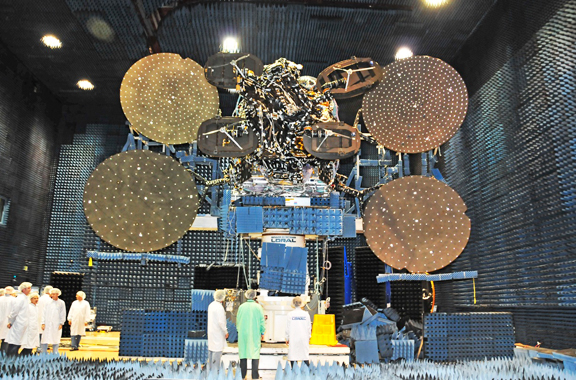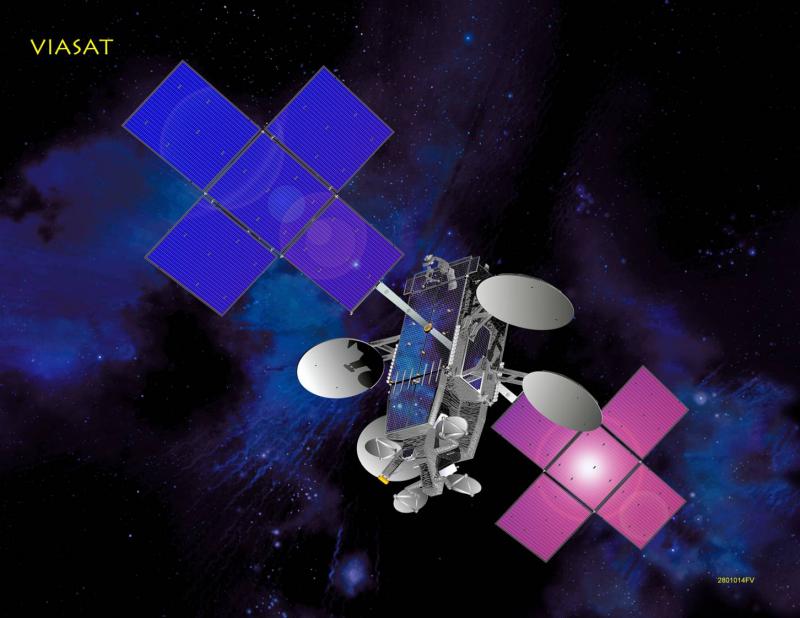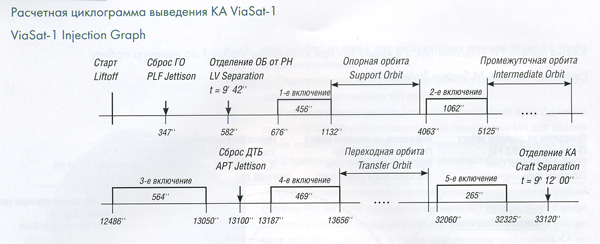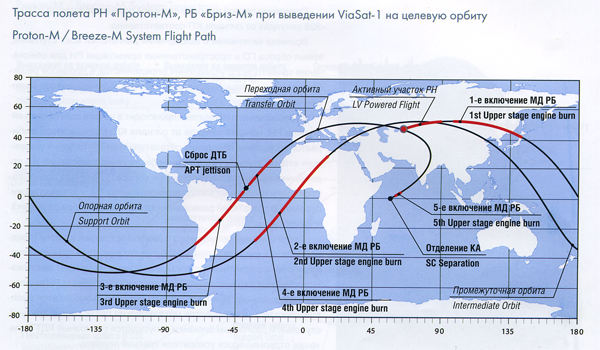- Joined
- Feb 13, 2008
- Messages
- 5,398
- Reaction score
- 8
- Points
- 0
- Location
- Khimki
- Website
- tigerofsiberia.livejournal.com
ViaSat-1 is the world's highest capacity satellite built by Space Systems/ Loral for ViaSat, a U.S. communications company.
With 140 Gbps total throughput capacity, the new satellite can serve the accelerating growth in bandwidth demand for multimedia Internet access over the next decade. The download and upload speeds available on ViaSat-1 will be much faster than anything previously offered in the satellite industry, and will transform the quality of satellite broadband.
To be located in geostationary orbit at 115° West, the satellite will use 72 high-capacity Ka-band spot beams to cover North America and Hawaii, enabling a variety of new, satellite Internet access services beginning with WildBlue in the U.S. and Xplornet in Canada.
Then, beginning in 2012, the technology is also scheduled to begin delivering this new level of service to airline passengers aboard JetBlue Airways and Continental Airlines.
With a capacity estimated at 100 Gbps, ViaSat-1 is expected to be (at launch) the highest capacity satellite in the world:

ViaSat-1 involves a collaborative effort with ViaSat and the top satellite broadband leaders in the market, including Loral, Telesat, and Eutelsat. Loral invested in the Canadian coverage portion of the satellite in anticipation of Telesat using this capacity for the provision of broadband services throughout Canada. The satellite is planned for the Telesat 115 west longitude orbital slot as part of the agreement. Telesat will also provide telemetry, tracking & control operations for the satellite.
ViaSat-1 is the North American counterpart to Eutelsat's KA-SAT, a high capacity Ka-band broadband satellite launched for Europe in December 2010.



Launch location:
Baikonur Launch pad no. 200/39 46° 2'23.85"N, 63° 1'54.98"E
Launch dates and times:
{colsp=6}Launch times
Time Zone |
{colsp=6}
{colsp=6}
Live Coverage Of The Launch:
PAYLOAD
ViaSat-1 communication satellite:

Mission Summary
{colsp=2}Summary
Parameter | Value
Coverage Map

Characteristics|
|

Launch Vehicle:
{colsp=2}Characteristics
 |
|
{colsp=2}

The vehicle's reliability statistics according to http://www.spacelaunchreport.com/log2011.html#rate:
ViaSat-1 Ascent Profile
The Proton-M first three stages place the orbital unit (OU), which consists of a Breeze-M upper stage, adapter system and KA-SAT, into 51.5° inclination suborbital trajectory.
Proton-M powered flight lasts 582 seconds. The OU powered flight begins at the moment of the third stage separation.

Immediately after the separation of the third stage booster, the Breeze-M stability engines ignite, damping the angular velocities of the third stage separation and then providing orbital unit orientation and stability during coast flight along a suborbital trajectory to await the first burn.
The upper stage follows a five-burn injection profile.
The first burn occurs 94 seconds after the Breeze-M separation from the launcher, forming a support orbit.
The second ignition is performed in the first ascending node of the support orbit, resulting in an intermediate orbit. The third main engine (ME) burn occurs at the intermediate orbit perigee in an ascending node. When the ME burns for the third time, it runs out the fuel in the additional fuel tank. The ME ignites for the fourth time 137 seconds after the third ME cutoff. The third and fourth ME burns form a transfer orbit with an apogee close to that of the target orbit. The additional propellant tank is jettisoned between the third and the fourth ME burns. The fifth ME burn is performed at the transfer orbit apogee in a descending node, placing OU into the target orbit.
Prior to each ME burn and APT separation, impulse correction engines fire to settle propellants in the tank.
During OU coast flight (i.e. the main engine is off) the upper stage control system turns OU to provide proper orientation for the spacecraft, generate thrust impulses, support radio control and separate the spacecraft.
Once in the target orbit, the orbital unit is stabilized for ViaSat-1 separation, following which the satellite is released.
Parameters of the final orbit are determined by the string pushers of the spacecraft/upper stage separation system.
After the craft separation GTO parameters are measured, and the upper stage is withdrawn to drift in a safe mode (pressures in all the containers are dropped).
The ViaSat-1 injection from liftoff to spacecraft separation is completed in 33,120 seconds, or 9 hours and 12 minutes.



ViaSat-1 Ascent Timeline
Event|Time rel lift-off|Time UTC|Comment
Ignition Start Sequence|-00:00:02.5|18:48:55.5 (Oct 19th)|
Stage 1 Ignition (40% thrust)|-00:00:01.75|18:48:56.25|
Command Stage 1 (100% thrust)|-00:00:00.9|18:48:57.1|
Maximum Dynamic Pressure|00:01:03|18:50:01|
1st/2nd Stage Separation|00:02:00|18:50:58|
2nd/3rd Stage Separation|00:05:27|18:54:25|
Payload Fairing Separation|00:05:47|18:54:45|
3rd Stage/Breeze M Separation|00:09:42|18:58:40|
1st Burn Ignition|00:11:16|19:00:14|
1st Burn Shutdown|00:18:52|19:07:50|1st Burn's Duration 00:07:36
2nd Burn Ignition|01:07:43|19:56:41|
2nd Burn Shutdown|01:25:25|20:14:23|2nd Burn's Duration 00:17:42
3rd Burn Ignition|03:28:06|22:17:04|
3rd Burn Shutdown|03:37:30|22:26:28|3rd Burn's Duration 00:09:24
APT Jettison|03:38:20|22:27:18|
4th Burn Ignition|03:39:47|22:28:45|
4th Burn Shutdown|03:47:36|22:36:34|4th Burn's Duration 00:07:49
5th Burn Ignition|08:54:20|3:43:18 (Oct 20th)|
5th Burn Shutdown|08:58:45|3:47:43|5th Burn's Duration 00:04:25
Spacecraft Separation|09:12:00|4:00:58|
Weather forecast for Baikonur, Kazakhstan on October 20, 2011 (1 a.m.)
Time|Temps|Wind|Chill|Heat Index|UV Index|Dew Point|Relative Humidity|Precip|Snow|Clouds|Visibility|Wind|Weather
1 AM|4°C|1°C|4°C|0|Low|-2°C|62%|0%|0%|0%|16KM|ENE 3.13 m/s|
 Clear
Clear
References
http://www.federalspace.ru
http://tvroscosmos.ru
http://www.khrunichev.ru
http://www.ilslaunch.com
http://tihiy.fromru.com/Rn/RN_Proton.htm
http://www.viasat.com
http://kbhmisaeva.ru
http://cosmopark.ru
http://www.tsenki.com
http://forum.nasaspaceflight.com
http://www.novosti-kosmonavtiki.ru
http://www.spacelaunchreport.com
http://www.intellicast.com/Local/Forecast.aspx
With 140 Gbps total throughput capacity, the new satellite can serve the accelerating growth in bandwidth demand for multimedia Internet access over the next decade. The download and upload speeds available on ViaSat-1 will be much faster than anything previously offered in the satellite industry, and will transform the quality of satellite broadband.
To be located in geostationary orbit at 115° West, the satellite will use 72 high-capacity Ka-band spot beams to cover North America and Hawaii, enabling a variety of new, satellite Internet access services beginning with WildBlue in the U.S. and Xplornet in Canada.
Then, beginning in 2012, the technology is also scheduled to begin delivering this new level of service to airline passengers aboard JetBlue Airways and Continental Airlines.
With a capacity estimated at 100 Gbps, ViaSat-1 is expected to be (at launch) the highest capacity satellite in the world:

ViaSat-1 involves a collaborative effort with ViaSat and the top satellite broadband leaders in the market, including Loral, Telesat, and Eutelsat. Loral invested in the Canadian coverage portion of the satellite in anticipation of Telesat using this capacity for the provision of broadband services throughout Canada. The satellite is planned for the Telesat 115 west longitude orbital slot as part of the agreement. Telesat will also provide telemetry, tracking & control operations for the satellite.
ViaSat-1 is the North American counterpart to Eutelsat's KA-SAT, a high capacity Ka-band broadband satellite launched for Europe in December 2010.


Launch location:
Baikonur Launch pad no. 200/39 46° 2'23.85"N, 63° 1'54.98"E
Launch dates and times:
Time Zone |
Australia - Sydney/AEST
|
Baikonur / UTC+6
|
Moscow / MSK/
|
Universal / UTC
|
Washington / EST
Launch time (Primary):
|
5:48:59 a.m.
|
00:48:58
|
22:48:58
|
18:48:58
|
2:48:68 p.m.
on:
|
Oct. 20, 2011
|
Oct. 20, 2011
|
Oct. 19, 2011
|
Oct. 19, 2011
|
Oct. 19, 2011
{colsp=6}
[highlight][eventTimer]2011-10-19 18:48:58?before|after;%dd% Days %hh% Hours %mm% Minutes %ss% Seconds %c%[/eventTimer] ViaSat-1 Launch[/highlight]
{colsp=6}
[eventTimer]2011-10-20 4:00:58?before|after;%dd% Days %hh% Hours %mm% Minutes %ss% Seconds %c%[/eventTimer] ViaSat-1 Separation From the Launch Vehicle
Live Coverage Of The Launch:
- International Launch Services: http://viasat1.imgondemand.com/ (begins at 20 minutes before lift-off)
- TSENKI Video Streams: http://www.tsenki.com/broadcast/broadcast/ - coverage since 20:50 MSK (5:50 p.m. UTC) till 23:50 MSK (8:50 UTC)
- Khrunichev COOPI (no password is required): http://coopi.khrunichev.ru/main.php?id=201
- Owners of PDA can watch the launch in test mode on: http://www.space-center.ru
- Satellite TV broadcast details are at http://www.ilslaunch.com/newsroom/news-releases/media-advisory-ils-proton-launch-viasat-1
PAYLOAD
ViaSat-1 communication satellite:

Mission Summary
Parameter | Value
Working Orbit:
|
GEO
Orbital Location:
|
115° West
Coverage:
|
C0NUS, Alaska, Hawaii, Canada
ApA at separation:
|
35 786 km
PeA at separation:
|
2 363 km
Inc at separation:
|
30.4°Coverage Map

ViaSat-1
Customer:
|- ViaSat Inc.
Prime contractor:
|- Space Systems/Loral

Platform:
|- LS-1300E
Mass at Separation:
|- 6 740 kg
Dry Mass:
|- 3 650 kg
Stabilization:
|- 3 axis stabilized
Dimensions (stowed):
|- 3.409 x 3.061 x 8.733 m
Payload:
|- Ka-band: 56 transponders
Forward Link (Internet to User)
|- Gateway Uplink 28.1-29.1 GHz and 29.5-30.0 GHz
- User Downlink 18.3-19.3 GHz and 19.7-20.2 GHz
Return Link (User to Internet)
|- User Uplink 28.1-29.1 GHz and 29.5-30.0 GHz
- Gateway Downlink 18.3-19.3 GHz and 19.7-20.2 GHz
Life time:
|- 15 years
|

Launch Vehicle:

Proton-M / Briz-M
Prime contractor:
|- Khrunichev Space Centre

GRAU Index:
|- 8K82KM
Height:
| 58.2 m with upper stage and payload fairingDiameter:
| max 7.4 mLiftoff mass:
| 705 metric tonnesPayload mass:
| ~22 tonnes at LEO1st stage:
|- 6 X RD-275 engines
- Empty 30.6 tonnes
- Propellants 419.41 tonnes (UDMH and NTO)
- Thrust in vacuum 1069.8 tonnes of force
- Thrust at sea level 971.4 tonnes of force
2nd stage:
|- 1 X RD-0211 engine 3 X RD-0210 engines
- Empty 11.4 tonnes
- Propellants 156.113 tonnes (UDMH and NTO)
- Thrust in vacuum 237.4 tonnes of force
3rd stage:
|- 1 X RD-0213 engine & 1 X RD-0214 vernier engine
- Empty 3.7 tonnes
- Propellants 46.562 tonnes (UDMH and NTO)
- Thrust in vacuum 59.36 (core) + 3.15 (vernier) tonnes of force
Upper Stage:
|

- GRAU Index: 14S43
- Common Name: Briz-M
- Designer & Manufacturer: Khrunichev Space Centre
- Dimensions: Length 2.654 m, Diameter 4 m
- Empty Mass 2.2 tonnes
- Propellants 6 660 kg UDMH + 13 260 kg N2O4
- Flight time: no less than 24 hours
- Main Engine: 1 X 14D30
- Thrust in vacuum 2.0 tonnes of force
- ISP 328.6 s
- Main engine restarts: up to 8 times
- Precision Manoeuvering Engines: 4 X 11D458
- Thrust in vacuum 400 N each
- ISP 252 s
- RCS Engines: 12 X 17D58E
- Thrust in vacuum 13.3 N each
- ISP 274 s
Payload Fairing:
|- Diameter 4.35 m
- Length 11.6 m
The vehicle's reliability statistics according to http://www.spacelaunchreport.com/log2011.html#rate:
Code:
================================================================
Vehicle Successes/Tries Realzd Pred Consc. Last Dates
Rate Rate* Succes Fail
================================================================
Proton-M/Briz-M 44 48 .92 .90 2 08/17/11 2001-ViaSat-1 Ascent Profile
The Proton-M first three stages place the orbital unit (OU), which consists of a Breeze-M upper stage, adapter system and KA-SAT, into 51.5° inclination suborbital trajectory.
Proton-M powered flight lasts 582 seconds. The OU powered flight begins at the moment of the third stage separation.

Immediately after the separation of the third stage booster, the Breeze-M stability engines ignite, damping the angular velocities of the third stage separation and then providing orbital unit orientation and stability during coast flight along a suborbital trajectory to await the first burn.
The upper stage follows a five-burn injection profile.
The first burn occurs 94 seconds after the Breeze-M separation from the launcher, forming a support orbit.
The second ignition is performed in the first ascending node of the support orbit, resulting in an intermediate orbit. The third main engine (ME) burn occurs at the intermediate orbit perigee in an ascending node. When the ME burns for the third time, it runs out the fuel in the additional fuel tank. The ME ignites for the fourth time 137 seconds after the third ME cutoff. The third and fourth ME burns form a transfer orbit with an apogee close to that of the target orbit. The additional propellant tank is jettisoned between the third and the fourth ME burns. The fifth ME burn is performed at the transfer orbit apogee in a descending node, placing OU into the target orbit.
Prior to each ME burn and APT separation, impulse correction engines fire to settle propellants in the tank.
During OU coast flight (i.e. the main engine is off) the upper stage control system turns OU to provide proper orientation for the spacecraft, generate thrust impulses, support radio control and separate the spacecraft.
Once in the target orbit, the orbital unit is stabilized for ViaSat-1 separation, following which the satellite is released.
Parameters of the final orbit are determined by the string pushers of the spacecraft/upper stage separation system.
After the craft separation GTO parameters are measured, and the upper stage is withdrawn to drift in a safe mode (pressures in all the containers are dropped).
The ViaSat-1 injection from liftoff to spacecraft separation is completed in 33,120 seconds, or 9 hours and 12 minutes.



ViaSat-1 Ascent Timeline
Ignition Start Sequence|-00:00:02.5|18:48:55.5 (Oct 19th)|
Stage 1 Ignition (40% thrust)|-00:00:01.75|18:48:56.25|
Command Stage 1 (100% thrust)|-00:00:00.9|18:48:57.1|
Maximum Dynamic Pressure|00:01:03|18:50:01|
1st/2nd Stage Separation|00:02:00|18:50:58|
2nd/3rd Stage Separation|00:05:27|18:54:25|
Payload Fairing Separation|00:05:47|18:54:45|
3rd Stage/Breeze M Separation|00:09:42|18:58:40|
1st Burn Ignition|00:11:16|19:00:14|
1st Burn Shutdown|00:18:52|19:07:50|1st Burn's Duration 00:07:36
2nd Burn Ignition|01:07:43|19:56:41|
2nd Burn Shutdown|01:25:25|20:14:23|2nd Burn's Duration 00:17:42
3rd Burn Ignition|03:28:06|22:17:04|
3rd Burn Shutdown|03:37:30|22:26:28|3rd Burn's Duration 00:09:24
APT Jettison|03:38:20|22:27:18|
4th Burn Ignition|03:39:47|22:28:45|
4th Burn Shutdown|03:47:36|22:36:34|4th Burn's Duration 00:07:49
5th Burn Ignition|08:54:20|3:43:18 (Oct 20th)|
5th Burn Shutdown|08:58:45|3:47:43|5th Burn's Duration 00:04:25
Spacecraft Separation|09:12:00|4:00:58|
Weather forecast for Baikonur, Kazakhstan on October 20, 2011 (1 a.m.)
1 AM|4°C|1°C|4°C|0|Low|-2°C|62%|0%|0%|0%|16KM|ENE 3.13 m/s|

References
http://www.federalspace.ru
http://tvroscosmos.ru
http://www.khrunichev.ru
http://www.ilslaunch.com
http://tihiy.fromru.com/Rn/RN_Proton.htm
http://www.viasat.com
http://kbhmisaeva.ru
http://cosmopark.ru
http://www.tsenki.com
http://forum.nasaspaceflight.com
http://www.novosti-kosmonavtiki.ru
http://www.spacelaunchreport.com
http://www.intellicast.com/Local/Forecast.aspx
Last edited:




















